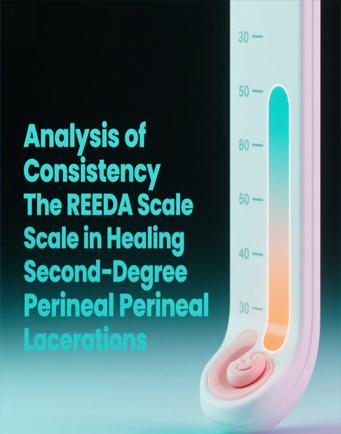Effectiveness of Hae-Band in Measuring Hb Levels in Postpartum Hemorrhage Risk Monitoring
Downloads
Postpartum hemorrhage is the main cause of high morbidity in the world (75%). Until now, efforts to early detect the risk of postpartum hemorrhage have still not been maximized. Sensor-based smartband can be the development of non-invasive methods in an effort to early detection of declining Hb levels in monitoring the risk of bleeding with practical, fast, precise, accurate, and practical. This research aims to determine the effectiveness of developing and analyzing the effectiveness of the "Hae-band" smartband in monitoring the risk of postpartum hemorrhage. The research method used is Research and Development (R&D), a quasi-experimental one-group pretest-posttest design using a nonequivalent dependent variable. The sampling technique in this research uses non-probability sampling with purposive sampling type. Respondents were selected by purposive sampling with a sample of 35 respondents maternity up to 6 hours postpartum to measure Hb levels and analyze the average levels of Hb and declining levels of HB Hae-band, HB meter POCT and visual estimation of blood loss volume compared with HB meter POCT (gold standard). Data analysis using the descriptive test, validation test, Paired T-Test, Independent T-Test, and multiple linear regression. The research results show that the Hae-band has been developed and is feasible as a measure of Hb levels which has a sensitivity of truth tool as much as 70.0% and can detect a decrease in Hb levels as much as 63.9% (p=0.000) more partially effective than visual estimation (0.24%) Smartband can detect Hb levels with good results compared to the gold standard of blood tests with a difference of 0.324 g/dL (p.0.113) with an average Hb levels at 6 hours PP at 11.19 g/dL compared to the average POCT 11.34 g/dL. This research concludes that Hae-band is more effective in detecting postpartum hemorrhage risk than visual estimation. It is hoped that further research can develop a more modern design where the sensor is more comfortable to use for long periods and has an alternative way of reading the sensor other than on the wrist. Improving accuracy, sensitivity, and higher battery power by improving the type of design, sensor, and wave type to be more suitable for measuring Hb levels can also be developed considering the efficiency of maternal monitoring and recording in the era of digitalization in early detection of bleeding risk.
Adisasmita, A. C. (2018). Pengalaman Review Kematian Ibu Dengan Sebab Kematian Pendarahan Pasca Persalinan Menggunakan Metode Confidental Enquiry Into Maternal Death (CEMD). (Patent No. EC00201824152). Universitas Indonesia.
Alfiana, R. D., Zakaria, H., Shahib, M. N., & Susanto, H. (2019). Accuracy of Hemoglobin Measurement Using Noninvasive Oxyhemoglobinometer in Pregnant Women at Health Center of Bantul District. Jurnal Ners dan Kebidanan Indonesia, 6(1), 59-64. https://doi.org/10.21927/jnki.2018.6(1).59-64
Aminnuddin, S. (2021). Alat Pendeteksi Hemoglobin Non Invasive. Diploma thesis. Universitas Widya Husada Semarang.
Bell, S. F., Watkins, A., John, M., Macgillivray, E., Kitchen, T. L., James, D., ... & Collins, P. W. (2020). Incidence of postpartum haemorrhage defined by quantitative blood loss measurement: a national cohort. BMC pregnancy and childbirth, 20, 1-9. https://doi.org/10.1186/s12884-020-02971-3.
Diaz, V., Abalos, E., & Carroli, G. (2018). Methods for blood loss estimation after vaginal birth. Cochrane Database of Systematic Reviews, (9). https://doi.org/10.1002/14651858.CD010980.pub2.
Dinas Kesehatan Jawa Timur. (2021). Profil Kesehatan Provinsi Jawa Timur. Surabaya: Dinas Kesehatan Jawa Timur.
Dinas Kesehatan Kabupaten Jember. (2022). Profil Kesehatan Kabupaten Jember 2021. Jember: Dinas Kesehatan Kabupaten Jember
Fasiha, F., Wabula, W. M., & Nendissa, M. M. (2022). Pengaruh Persalinan Normal Terhadap Penurunan Kadar Hemoglobin Pada Ibu Postpartum Di Rumah Sakit Al Fatah Ambon. Jurnal Kebidanan, 2(1), 10-15.
Hasan, M. K., Aziz, M. H., Zarif, M. I. I., Hasan, M., Hashem, M. M. A., Guha, S., ... & Ahamed, S. (2021). Noninvasive hemoglobin level prediction in a mobile phone environment: State of the art review and recommendations. JMIR mHealth and uHealth, 9(4), e16806.
Jahan, E., Barua, T., & Salma, U. (2014). An overview on heart rate monitoring and pulse oximeter system. Int. J. Latest Res. Sci. Technol, 3(5), 148-152. https://doi.org/10.33096/woh.v6i01.284.
James, A. H., Federspiel, J. J., & Ahmadzia, H. K. (2022). Disparities in obstetric hemorrhage outcomes. Research and Practice in Thrombosis and Haemostasis, 6(1), e12656. https://doi.org/10.1002/rth2.12656.
Julieta, N. P. N., & Giri, M. K. W. (2021). Postpartum Hemorrhage: Kegawatdaruratan dalam Persalinan Ibu Hamil. Ganesha Medicina, 1(1), 48-65. https://doi.org/10.23887/gm.v1i1.31709.
Karina, P., & Thohari, A. H. (2018). Perancangan Alat Pengukur Detak Jantung Menggunakan Pulse Sensor Berbasis Raspberry. Journal of Applied Informatics and Computing, 2(2), 57–61. https://doi.org/10.30871/jaic.v2i2.920.
Katz, D., & Farber, M. K. (2021). Can measuring blood loss at delivery reduce hemorrhage-related morbidity? International Journal of Obstetric Anesthesia, 46, 102968. https://doi.org/10.1016/j.ijoa.2021.102968.
Kemalasari, & Rochmad, M. (2022). Deteksi Kadar Saturasi Oksigen Darah (Spo2) Dan Detak Jantung Secara Non-Invasif Dengan Sensor Chip Max30100. Jurnal Nasional Teknologi Terapan (JNTT), 4(1), 35–50. https://doi.org/10.22146/jntt.v4i1.4804.
Kementerian Kesehatan Republik Indonesia. (2022). Profil Kesehatan Indonesia 2021. Kementerian Kesehatan Republik Indonesia.
Liu, H., Peng, F., Hu, M., Shi, J., Wang, G., Ai, H., & Wang, W. (2020). Development and validation of a photoplethysmography system for noninvasive monitoring of hemoglobin concentration. Journal of Electrical and Computer Engineering, 2020(1), 3034260. https://doi.org/10.1155/2020/3034260.
Muhammad, A. (2012). Rancang Bangun Sistem Pengukuran Kadar Hemoglobin Darah Berbasis Mikrokontroler. Skripsi Tesis. Universitas Airlangga.
Muthmainnah, M., & Tabriawan, D. B. (2022). Prototipe Alat Ukur Detak Jantung Menggunakan Sensor MAX30102 Berbasis Internet of Things (IoT) ESP8266 dan Blynk. JISKA (Jurnal Informatika Sunan Kalijaga), 7(3), 163–176. https://doi.org/10.14421/jiska.2022.7.3.163-176.
Nidianti, E., Nugraha, G., Aulia, I. A. N., Syadzila, S. K., Suciati, S. S., & Utami, N. D. (2019). Pemeriksaan Kadar Hemoglobin dengan Metode POCT (Point of Care Testing) sebagai Deteksi Dini Penyakit Anemia Bagi Masyarakat Desa Sumbersono, Mojokerto. Jurnal Surya Masyarakat, 2(1), 29-34. https://doi.org/10.26714/jsm.2.1.2019.29-34.
Ningsi, A., Sonda, M., & Afriani. (2023). Asuhan Kegawatdaruratan Maternal Neonatal. Nas Media Indonesia.
Obuna, J. A., Anikwe, C. C., Ejikeme, B. N., & Ndulue, J. (2020). Visual estimation of blood loss post delivery: How accurate are we in a poor resource setting. International Research Journal of Medicine and Biomedical Sciences, 5(3), 24–28.
Pratama, A. I., Sahara, A., & Agsari, S. I. (2020). Analysis of Blood Hemoglobin Levels Using Biosensors Based on Heme Oxygenase from Serratia marcescens. Current Biochemistry, 7(1), 37–46. https://doi.org/10.29244/cb.7.1.5.
Putra, M. A. R., Yo, E. C., Phowira, J., & Anggraeni, T. D. (2020). Upaya Menurunkan Angka Kematian Ibu akibat Perdarahan Pasca-Persalinan di Indonesia melalui Inovasi Sistem Pelayanan Kesehatan. Cermin Dunia Kedokteran, 47(10), 785-791. https://doi.org/10.55175/cdk.v47i12.1250
Sada, S., Aliyu, R., Umar, H., Randawa, A., & Onwuhafua, P. (2021). A Comparative Study of Postpartum Blood Loss Using Visual Method and Blood Collection Drape in a Northwestern Hospital. Tropical Journal of Obstetrics and Gynaecology, 38(1), 20-27.
Simanjuntak, L. (2020). Perdarahan Postpartum (Perdarahan Paskasalin). Jurnal Visi Eksakta, 1(1), 1-10. https://doi.org/10.37341/interest.v0i0.345.
Siregar, M. H., Koerniawati, R. D., Sijabat, A. I. Y., Utami, H., & Nurkhairani, A. (2023). Perbandingan Kadar Hemoglobin Ibu Hamil menggunakan Metode Digital dengan Metode Cyanmethemoglobin. Faletehan Health Journal, 10(02), 178–184. https://doi.org/10.33746/fhj.v10i02.603.
Sugiyono. (2022). Metode Penelitian Kuantitatif, Kualitatif dan R&D. Bandung: Alfabeta.
Thurer, R. L., Doctorvaladan, S., Carvalho, B., & Jelks, A. T. (2022). Limitations of Gravimetric Quantitative Blood Loss during Cesarean Delivery. American Journal of Perinatology, 12(1), E36–E40. https://doi.org/10.1055/s-0041-1742267.
WHO. (2022). WHO Postapartum Haemorrhage (PPH) Summit. World Health Organization.
Wisana, I. D. G. H. W., Nugraha, P. C., Amrinsani, F., Sani, F. F., Anwar, Y. I., & Palanisamy, S. (2022). Smartband for Heartbeat and Oxygen Saturation Monitoring with Critical Warning to Paramedic via IoT. Jurnal Teknokes, 15(3), 161–166. https://doi.org/10.35882/teknokes.v15i3.317
Copyright (c) 2024 JURNAL INFO KESEHATAN

This work is licensed under a Creative Commons Attribution-NonCommercial-ShareAlike 4.0 International License.
Copyright notice
Ownership of copyright
The copyright in this website and the material on this website (including without limitation the text, computer code, artwork, photographs, images, music, audio material, video material and audio-visual material on this website) is owned by JURNAL INFO KESEHATAN and its licensors.
Copyright license
JURNAL INFO KESEHATAN grants to you a worldwide non-exclusive royalty-free revocable license to:
- view this website and the material on this website on a computer or mobile device via a web browser;
- copy and store this website and the material on this website in your web browser cache memory; and
- print pages from this website for your use.
- All articles published by JURNAL INFO KESEHATAN are licensed under the Creative Commons Attribution 4.0 International License. This permits anyone to copy, redistribute, remix, transmit and adapt the work provided the original work and source is appropriately cited.
JURNAL INFO KESEHATAN does not grant you any other rights in relation to this website or the material on this website. In other words, all other rights are reserved.
For the avoidance of doubt, you must not adapt, edit, change, transform, publish, republish, distribute, redistribute, broadcast, rebroadcast or show or play in public this website or the material on this website (in any form or media) without appropriately and conspicuously citing the original work and source or JURNAL INFO KESEHATAN prior written permission.
Permissions
You may request permission to use the copyright materials on this website by writing to jurnalinfokesehatan@gmail.com.
Enforcement of copyright
JURNAL INFO KESEHATAN takes the protection of its copyright very seriously.
If JURNAL INFO KESEHATAN discovers that you have used its copyright materials in contravention of the license above, JURNAL INFO KESEHATAN may bring legal proceedings against you seeking monetary damages and an injunction to stop you using those materials. You could also be ordered to pay legal costs.
If you become aware of any use of JURNAL INFO KESEHATAN copyright materials that contravenes or may contravene the license above, please report this by email to jurnalinfokesehatan@gmail.com
Infringing material
If you become aware of any material on the website that you believe infringes your or any other person's copyright, please report this by email to jurnalinfokesehatan@gmail.com.





































